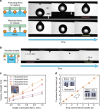Mechano-regulated surface for manipulating liquid droplets
- PMID: 28374739
- PMCID: PMC5382277
- DOI: 10.1038/ncomms14831
Mechano-regulated surface for manipulating liquid droplets
Abstract
The effective transfer of tiny liquid droplets is vital for a number of processes such as chemical and biological microassays. Inspired by the tarsi of meniscus-climbing insects, which can climb menisci by deforming the water/air interface, we developed a mechano-regulated surface consisting of a background mesh and a movable microfibre array with contrastive wettability. The adhesion of this mechano-regulated surface to liquid droplets can be reversibly switched through mechanical reconfiguration of the microfibre array. The adhesive force can be tuned by varying the number and surface chemistry of the microfibres. The in situ adhesion of the mechano-regulated surface can be used to manoeuvre micro-/nanolitre liquid droplets in a nearly loss-free manner. The mechano-regulated surface can be scaled up to handle multiple droplets in parallel. Our approach offers a miniaturized mechano-device with switchable adhesion for handling micro-/nanolitre droplets, either in air or in a fluid that is immiscible with the droplets.
Conflict of interest statement
The authors declare no competing financial interests.
Figures







References
-
- Dorvee J. R., Derfus A. M., Bhatia S. N. & Sailor M. J. Manipulation of liquid droplets using amphiphilic, magnetic one-dimensional photonic crystal chaperones. Nat. Mater. 3, 896–899 (2004). - PubMed
-
- Velev O. D., Prevo B. G. & Bhatt K. H. On-chip manipulation of free droplets. Nature 426, 515–516 (2003). - PubMed
-
- Aussillous P. & Quéré D. Liquid marbles. Nature 411, 924–927 (2001). - PubMed
-
- Chaudhury M. K. & Whitesides G. M. How to make water run uphill. Science 256, 1539–1541 (1992). - PubMed
-
- Cho S. K., Moon H. & Kim C.-J. Creating, transporting, cutting, and merging liquid droplets by electrowetting-based actuation for digital microfluidic circuits. J. Microelectromech. Syst. 12, 70–80 (2003).
Publication types
MeSH terms
LinkOut - more resources
Full Text Sources
Other Literature Sources

